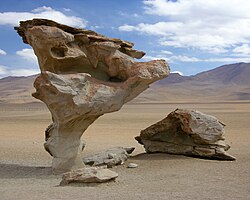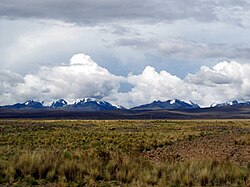Altiplano
| People | Qulla |
|---|---|
| Language | Qichwa |
| Country | Qullaw |
The Altiplano (
There are on the plateau many towns and several cities, including
The Altiplano was the site of several pre-Columbian cultures, including the Chiripa,
Today, major economic activities in the Altiplano include mining, llama and vicuña herding, and services (in its cities). The area also attracts some international tourism.
Geography


The Altiplano is an area of inland drainage (
The Altiplano is noted for
.Geology

Several mechanisms have been put forth for the formation of the Altiplano plateau; hypotheses try to explain why the topography in the Andes incorporates this large area of low relief at high altitude (high plateau) within the orogen:
- Existence of weaknesses in the Earth's crust prior to tectonic shortening. Such weaknesses would cause the partition of tectonic deformation and uplift into the eastern and western cordillera, leaving the necessary space for the formation of the altiplano basin.
- Magmatic processes rooted in the asthenosphere might have contributed to uplift of the plateau.[5][6]
- Climate has controlled the spatial distribution of erosion and sediment deposition, controlling the lubrication along the subducting Nazca Plateand hence influencing the transmission of tectonic forces into South America.
- Climate also determined the formation of internal drainage (endorheism) and sediment trapping within the Andes, potentially blocking tectonic deformation in the central area between the two cordilleras, and expelling deformation towards the flanks of the orogen.[7]
- Convective removal of the dense lower lithosphere beneath the Altiplano caused that region to isostatically 'float' higher.
At various times during the
Climate

The term Altiplano is sometimes used to identify the altitude zone and the type of climate that prevails within it: it is colder than that of the
In general the climate is cool and humid to semi-arid and even
The coldest temperatures occur in the southwestern portion of the Altiplano during the winter months of June and July. The seasonal cycle of rainfall is marked, with the rainy season concentrated between December and March. The rest of the year tends to be very dry, cool, windy and sunny. Snowfall may happen between April and September, especially to the north, but it is not very common, occurring between one and five times a year.
See also
References
- ^ Mercado, David. "Lake Poopo Dries Up". Reuters. Archived from the original on 19 December 2015.
- ^ Paskevics, Emily (19 December 2015). "Lake Poopó, Second Largest In Bolivia, Dries Up Completely". Headlines & Global News (HNGN). Archived from the original on 9 February 2016.
- ^ "The Use of Solar Energy for Improving the Living Conditions in Altiplano/Argentina" (PDF). Archived from the original (PDF) on 2011-07-19. Retrieved 2009-10-10.
- ^ "Andes map". Archived from the original on 2010-09-24. Retrieved 2010-06-19.
- S2CID 201291787.
- PMID 32321945.
External links
- Photo Gallery of Altiplano in Argentina, Bolivia and Chile
- Photo Gallery: Argentinian Puna
- Water resources of Chilean Altiplano
- Steinmetz, George (July 2008). "Altiplano - Where Bolivia meets the sky". National Geographic Magazine. Archived from the originalon June 30, 2008.

